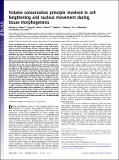Volume conservation principle involved in cell lengthening and nucleus movement during tissue morphogenesis
Author(s)
Gelbart, Michael A.; He, Bing; Thiberge, Stephan Y.; Wieschaus, Eric F.; Kaschube, Matthias; Martin, Adam C; ... Show more Show less
DownloadMartin-2012-A volume conservation principle involved in cell lengthening.pdf (1.983Mb)
PUBLISHER_POLICY
Publisher Policy
Article is made available in accordance with the publisher's policy and may be subject to US copyright law. Please refer to the publisher's site for terms of use.
Terms of use
Metadata
Show full item recordAbstract
Tissue morphogenesis is the process in which coordinated movements and shape changes of large numbers of cells form tissues, organs, and the internal body structure. Understanding morphogenetic movements requires precise measurements of whole-cell shape changes over time. Tissue folding and invagination are thought to be facilitated by apical constriction, but the mechanism by which changes near the apical cell surface affect changes along the entire apical–basal axis of the cell remains elusive. Here, we developed Embryo Development Geometry Explorer, an approach for quantifying rapid whole-cell shape changes over time, and we combined it with deep-tissue time-lapse imaging based on fast two-photon microscopy to study Drosophila ventral furrow formation. We found that both the cell lengthening along the apical–basal axis and the movement of the nucleus to the basal side proceeded stepwise and were correlated with apical constriction. Moreover, cell volume lost apically due to constriction largely balanced the volume gained basally by cell lengthening. The volume above the nucleus was conserved during its basal movement. Both apical volume loss and cell lengthening were absent in mutants showing deficits in the contractile cytoskeleton underlying apical constriction. We conclude that a single mechanical mechanism involving volume conservation and apical constriction-induced basal movement of cytoplasm accounts quantitatively for the cell shape changes and the nucleus movement in Drosophila ventral furrow formation. Our study provides a comprehensive quantitative analysis of the fast dynamics of whole-cell shape changes during tissue folding and points to a simplified model for Drosophila gastrulation.
Date issued
2012-11Department
Massachusetts Institute of Technology. Department of BiologyJournal
Proceedings of the National Academy of Sciences
Publisher
National Academy of Sciences
Citation
Gelbart, M. A., B. He, A. C. Martin, S. Y. Thiberge, E. F. Wieschaus, and M. Kaschube. Volume Conservation Principle Involved in Cell Lengthening and Nucleus Movement During Tissue Morphogenesis. Proceedings of the National Academy of Sciences 109, no. 47 (November 20, 2012): 19298-19303.
Version: Final published version
ISSN
0027-8424
1091-6490